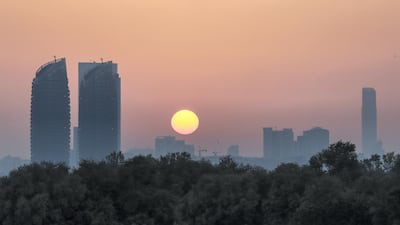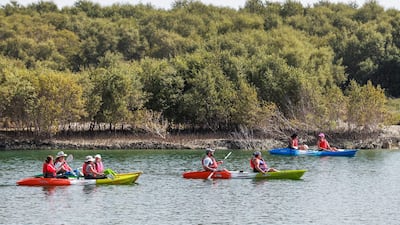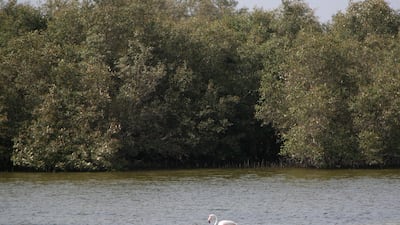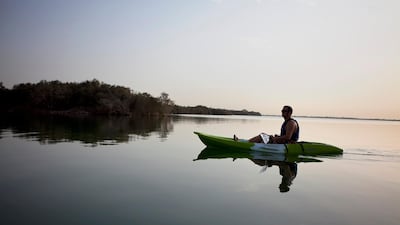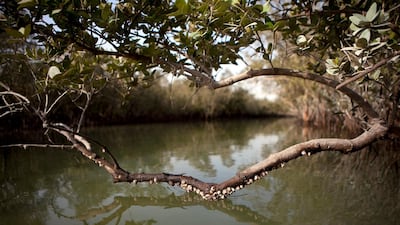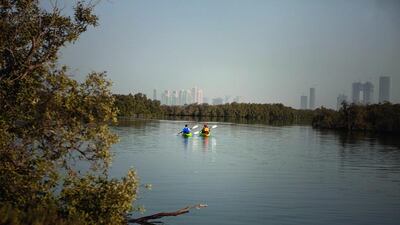As the world’s climate changes, experts have said that mangroves have an increasingly important role to play as carbon sinks and as protection against changes to sea levels.
While mangroves are threatened by human activity — Unesco said that they are disappearing up to five times as fast as forests — there are examples from around the world and closer to home that show how they can be protected in the face of development.
The importance of mangroves was highlighted recently by the International Day for the Conservation of the Mangrove Ecosystem, a Unesco event that included a warning about the threats they face.
Development has been one of the most significant challenges and balancing how development takes place with mangrove conservation
Prof Nidal Hilal,
NYU Abu Dhabi
Audrey Azoulay, Unesco’s director-general, said in a statement that mangroves were “in danger”, with more than three-quarters threatened. And that comes after about half of them were lost over the past four decades.
Nidal Hilal, founding director and principal investigator of New York University Abu Dhabi’s Water Research Centre, described mangroves as “crucial contributors to the well-being of coastal communities”.
The UAE is home to more than a dozen mangrove sites and has plans to expand and develop their presence across the Emirates.
In November, Mariam Al Mheiri, Minister of Climate Change and Environment, announced at Cop26 in Glasgow that the UAE will plant 100 million mangroves by 2030.
Abu Dhabi also announced plans to establish the emirate as a global hub for research and innovation in support of the conservation of mangroves during Prince William's landmark visit to the UAE.
Growing importance
Mangrove peat absorbs excess water during heavy rain, he said, making flooding less likely, and mangroves reduce coastal erosion, with research showing that mangrove loss has made coasts more vulnerable.
“Waves initially go through mangrove forests before reaching the coast and they carry with them layers of mud and decaying plant matter,” Prof Hilal said.
“Mangroves act somewhat as a filter and trap some of these substances upon waves entering, reducing sedimentary erosion, which would damage the structure of shorelines.”
So, with global warming leading to higher sea levels, greater attention should, he said, be paid to their conservation.
Prof Hilal said mangroves were also important for bacteria and other decomposers, for invertebrates such as oysters and worms, for the fish and shrimp they are consumed by, and for the birds, reptiles and others that, in turn, eat them.
Their actions in filtering water and providing a nutrient-rich habitat are particularly important for fish, whose spawn can be protected by mangroves.
Alongside seagrass beds and saltwater marshes, mangroves make up what is sometimes known as blue forests, a maritime equivalent to land-based green forests.
“These blue forests, like the green forests that we all love and know, have a very important role in terms of carbon sequestration and storage,” said Niko Howai, a researcher at Reading University in the UK who is completing a PhD on mangroves on the Caribbean island of Tobago.
“Unlike their terrestrial counterparts, they don’t just take the carbon out of the atmosphere, but they also sink it into their roots and underground and they store it there. That in itself is a very important global benefit for mangroves, for why we should keep mangroves.”
Counteracting threats
Development of coastal areas, whether for ports, housing, tourism or other uses, can damage or lead to the removal of mangroves, and has been a big factor behind the losses of recent decades.
“Development has been one of the most significant challenges and balancing how development takes place with mangrove conservation,” Mr Howai said.
“The major problem comes from development and the associated things that can come from human activity, such as pollution.”
As coastlines become developed, there may be problems caused by sewage treatment plants discharging material, even if it has already been treated, because an excess of nutrients can prove harmful. Farming may also result in discharges that are damaging to mangroves.
Mr Howai said there were instances, however, of development apparently going hand-in-hand with the conservation of mangroves, such as the PIK Mangrove Nature Park in Jakarta, Indonesia, where huts and boardwalks have been built but the mangroves remain.
Another example of mangrove conservation that has attracted plaudits centres on Gazi Bay in Kenya. There, in a scheme organised through a British charity, the planting of mangrove seedlings is financed by the sale of carbon credits.
Alongside development, mangroves face significant threats from sea-level rises caused by climate change. This is an issue, Mr Howai said, in all areas where mangroves are found, from the tropics to the subtropics and warm temperate regions.
“Mangroves in the Caribbean and small island developing states are at much higher risk of negative impacts because being on a small island, the sea-level rise is likely to have a major impact on the availability of the coastal environment to house mangroves and for them to grow,” Mr Howai said.
Increasing temperatures, changes in rainfall and increases in the frequency of extreme weather events such as hurricanes and cyclones also have negative effects.
Although mangroves thrive in humid conditions and the heat, extreme temperatures, extreme weather and the climate affect how they develop and grow.
Climate change-induced damage to coral reefs, which act as a protective barrier for mangroves, can also harm mangroves.
In 2018, the Environment Agency Abu Dhabi estimated that one-fifth of the emirate’s mangroves were deteriorating or in moderate health.
Prof Hilal said that while urban expansion, pollution, physical damage and other factors continued to threaten mangroves, Abu Dhabi had made “substantial efforts” to minimise habitat losses and restore damaged areas.
“In response to historic losses of mangroves due to coastal developments, large-scale afforestation programmes and establishment of protected areas have increased mangrove cover in the UAE,” he said.
“An example of this is the opening of the Jubail Mangrove Park that helps protect biodiversity and raise awareness on Abu Dhabi’s rich mangrove ecosystem. The mangroves in the UAE are now the largest on the coast of the Arabian Gulf.”
So, as mangroves continue to face threats, case studies show that they can be protected if efforts are made.
Dubai launches mangrove-planting initiative to help protect the environment
UAE squad
Esha Oza (captain), Al Maseera Jahangir, Emily Thomas, Heena Hotchandani, Indhuja Nandakumar, Katie Thompson, Lavanya Keny, Mehak Thakur, Michelle Botha, Rinitha Rajith, Samaira Dharnidharka, Siya Gokhale, Sashikala Silva, Suraksha Kotte, Theertha Satish (wicketkeeper) Udeni Kuruppuarachchige, Vaishnave Mahesh.
UAE tour of Zimbabwe
All matches in Bulawayo
Friday, Sept 26 – First ODI
Sunday, Sept 28 – Second ODI
Tuesday, Sept 30 – Third ODI
Thursday, Oct 2 – Fourth ODI
Sunday, Oct 5 – First T20I
Monday, Oct 6 – Second T20I
Vidaamuyarchi
Director: Magizh Thirumeni
Stars: Ajith Kumar, Arjun Sarja, Trisha Krishnan, Regina Cassandra
Rating: 4/5
COMPANY%20PROFILE
%3Cp%3ECompany%20name%3A%20CarbonSifr%3Cbr%3EStarted%3A%202022%3Cbr%3EBased%3A%20Dubai%3Cbr%3EFounders%3A%20Onur%20Elgun%2C%20Mustafa%20Bosca%20and%20Muhammed%20Yildirim%3Cbr%3ESector%3A%20Climate%20tech%3Cbr%3EInvestment%20stage%3A%20%241%20million%20raised%20in%20seed%20funding%3Cbr%3E%3C%2Fp%3E%0A
Results
6.30pm: Baniyas (PA) Group 2 Dh195,000 1,400m | Winner: ES Ajeeb, Sam Hitchcock (jockey), Ibrahim Aseel (trainer)
7.05pm: Maiden (TB) Dh165,000 1,400m | Winner: Al Shamkhah, Royston Ffrench, Sandeep Jadhav
7.40pm: Handicap (TB) Dh190,000 1,200m | Winner: Lavaspin, Richard Mullen, Satish Seemar
8.15pm: Maiden (TB) Dh165,000 1,200m | Winner: Kawasir, Dane O’Neill, Musabah Al Muhairi
8.50pm: Rated Conditions (TB) Dh240,000 1,600m | Winner: Cosmo Charlie, Pat Dobbs, Doug Watson
9.20pm: Handicap (TB) Dh165,000 1,400m | Winner: Bochart, Richard Mullen, Satish Seemar
10pm: Handicap (TB) Dh175,000 2,000m | Winner: Quartier Francais, Fernando Jara, Ali Rashid Al Raihe
War 2
Director: Ayan Mukerji
Stars: Hrithik Roshan, NTR, Kiara Advani, Ashutosh Rana
Rating: 2/5
FIGHT INFO
Men’s 60kg Round 1:
Ahmad Shuja Jamal (AFG) beat Krisada Takhiankliang (THA) - points
Hyan Aljmyah (SYR) beat Akram Alyminee (YEM) - retired Round 1
Ibrahim Bilal (UAE) beat Bhanu Pratap Pandit (IND) - TKO Round 1
Men’s 71kg Round 1:
Seyed Kaveh Soleyman (IRI) beat Abedel Rahman (JOR) - RSC round 3.
Amine Al Moatassime (UAE) walk over Ritiz Puri (NEP)
The specs: 2017 Dodge Viper SRT
Price, base / as tested Dh460,000
Engine 8.4L V10
Transmission Six-speed manual
Power 645hp @ 6,200rpm
Torque 813Nm @ 5,000rpm
Fuel economy, combined 16.8L / 100km
The five pillars of Islam
Results
5.30pm Maiden (TB) Dh82,500 (Turf) 1,400m
Winner Spirit Of Light, Clement Lecoeuvre (jockey), Erwan Charpy (trainer)
6.05pm Maiden (TB) Dh82,500 (Dirt) 1,900m
Winner Bright Start, Pat Cosgrave, Saeed bin Suroor
6.40pm Handicap (TB) Dh92,500 (D) 2,000m
Winner Twelfthofneverland, Nathan Crosse, Satish Seemar
7.15pm Handicap (TB) Dh85,000 (T) 1,600m
Winner Imperial Empire, Tadhg O’Shea, Satish Seemar
7.50pm Handicap (TB) Dh92,500 (T) 2,000m
Winner Record Man, Tadhg O’Shea, Satish Seemar
8.25pm Handicap (TB) Dh92,500 (D) 1,600m
Winner Celtic Prince, Fabrice Veron, Rashed Bouresly
Company profile
Name: Tharb
Started: December 2016
Founder: Eisa Alsubousi
Based: Abu Dhabi
Sector: Luxury leather goods
Initial investment: Dh150,000 from personal savings
The bio
Favourite food: Japanese
Favourite car: Lamborghini
Favourite hobby: Football
Favourite quote: If your dreams don’t scare you, they are not big enough
Favourite country: UAE
Volvo ES90 Specs
Engine: Electric single motor (96kW), twin motor (106kW) and twin motor performance (106kW)
Power: 333hp, 449hp, 680hp
Torque: 480Nm, 670Nm, 870Nm
On sale: Later in 2025 or early 2026, depending on region
Price: Exact regional pricing TBA
How to help
Send “thenational” to the following numbers or call the hotline on: 0502955999
2289 – Dh10
2252 – Dh 50
6025 – Dh20
6027 – Dh 100
6026 – Dh 200
KILLING OF QASSEM SULEIMANI
If you go
The flights
Emirates and Etihad fly direct to Nairobi, with fares starting from Dh1,695. The resort can be reached from Nairobi via a 35-minute flight from Wilson Airport or Jomo Kenyatta International Airport, or by road, which takes at least three hours.
The rooms
Rooms at Fairmont Mount Kenya range from Dh1,870 per night for a deluxe room to Dh11,000 per night for the William Holden Cottage.
About Tenderd
Started: May 2018
Founder: Arjun Mohan
Based: Dubai
Size: 23 employees
Funding: Raised $5.8m in a seed fund round in December 2018. Backers include Y Combinator, Beco Capital, Venturesouq, Paul Graham, Peter Thiel, Paul Buchheit, Justin Mateen, Matt Mickiewicz, SOMA, Dynamo and Global Founders Capital
Winners
Ballon d’Or (Men’s)
Ousmane Dembélé (Paris Saint-Germain / France)
Ballon d’Or Féminin (Women’s)
Aitana Bonmatí (Barcelona / Spain)
Kopa Trophy (Best player under 21 – Men’s)
Lamine Yamal (Barcelona / Spain)
Best Young Women’s Player
Vicky López (Barcelona / Spain)
Yashin Trophy (Best Goalkeeper – Men’s)
Gianluigi Donnarumma (Paris Saint-Germain and Manchester City / Italy)
Best Women’s Goalkeeper
Hannah Hampton (England / Aston Villa and Chelsea)
Men’s Coach of the Year
Luis Enrique (Paris Saint-Germain)
Women’s Coach of the Year
Sarina Wiegman (England)
Key figures in the life of the fort
Sheikh Dhiyab bin Isa (ruled 1761-1793) Built Qasr Al Hosn as a watchtower to guard over the only freshwater well on Abu Dhabi island.
Sheikh Shakhbut bin Dhiyab (ruled 1793-1816) Expanded the tower into a small fort and transferred his ruling place of residence from Liwa Oasis to the fort on the island.
Sheikh Tahnoon bin Shakhbut (ruled 1818-1833) Expanded Qasr Al Hosn further as Abu Dhabi grew from a small village of palm huts to a town of more than 5,000 inhabitants.
Sheikh Khalifa bin Shakhbut (ruled 1833-1845) Repaired and fortified the fort.
Sheikh Saeed bin Tahnoon (ruled 1845-1855) Turned Qasr Al Hosn into a strong two-storied structure.
Sheikh Zayed bin Khalifa (ruled 1855-1909) Expanded Qasr Al Hosn further to reflect the emirate's increasing prominence.
Sheikh Shakhbut bin Sultan (ruled 1928-1966) Renovated and enlarged Qasr Al Hosn, adding a decorative arch and two new villas.
Sheikh Zayed bin Sultan (ruled 1966-2004) Moved the royal residence to Al Manhal palace and kept his diwan at Qasr Al Hosn.
Sources: Jayanti Maitra, www.adach.ae
GOLF’S RAHMBO
- 5 wins in 22 months as pro
- Three wins in past 10 starts
- 45 pro starts worldwide: 5 wins, 17 top 5s
- Ranked 551th in world on debut, now No 4 (was No 2 earlier this year)
- 5th player in last 30 years to win 3 European Tour and 2 PGA Tour titles before age 24 (Woods, Garcia, McIlroy, Spieth)
Jetour T1 specs
Engine: 2-litre turbocharged
Power: 254hp
Torque: 390Nm
Price: From Dh126,000
Available: Now
























